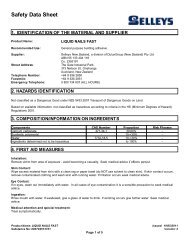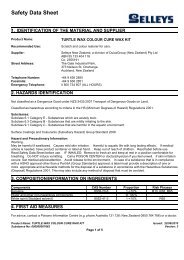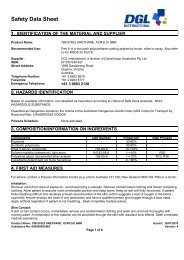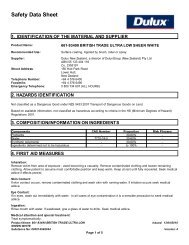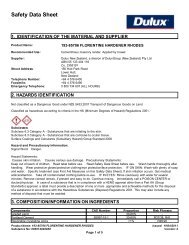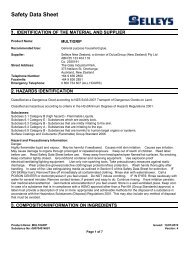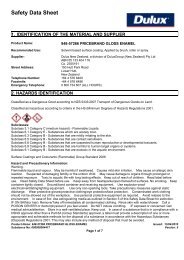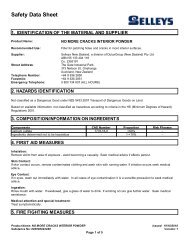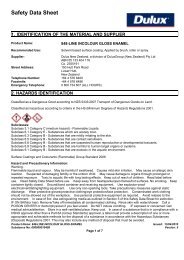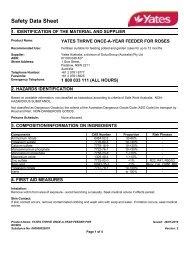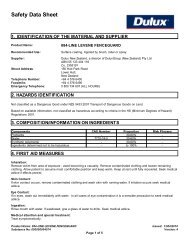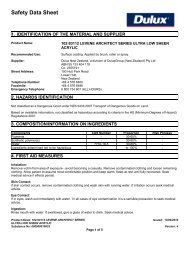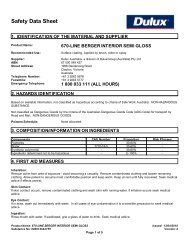yates orchid food - MSDS
yates orchid food - MSDS
yates orchid food - MSDS
Create successful ePaper yourself
Turn your PDF publications into a flip-book with our unique Google optimized e-Paper software.
Safety Data Sheet<br />
1. IDENTIFICATION OF THE MATERIAL AND SUPPLIER<br />
Product Name: YATES ORCHID FOOD<br />
Recommended Use: Soluble <strong>orchid</strong> fertiliser.<br />
Supplier: Yates New Zealand, a division of DuluxGroup (New Zealand) Pty Ltd<br />
ABN 55 133 404 118<br />
Co. 2355191<br />
Street Address: The Gate Industrial Park,<br />
373 Neilson St, Onehunga<br />
Auckland, New Zealand<br />
Telephone Number: +64 9 636 2800<br />
Facsimile: +64 9 636 2802<br />
Emergency Telephone: 0 800 734 607 (ALL HOURS)<br />
2. HAZARDS IDENTIFICATION<br />
Not classified as a Dangerous Good under NZS 5433:2012 Transport of Dangerous Goods on Land.<br />
Classified as hazardous according to criteria in the HS (Minimum Degrees of Hazard) Regulations 2001.<br />
Subclasses:<br />
Subclass 6.3 Category A - Substances that are irritating to the skin.<br />
Subclass 6.4 Category A - Substances that are irritating to the eye.<br />
Fertilisers (Subsidiary Hazard) Group Standard 2006<br />
Hazard and Precautionary Information:<br />
Warning.<br />
Causes skin irritation. Causes eye irritation. Keep out of reach of children. Read label before use. Read Safety Data<br />
Sheet before use. Wash hands thoroughly after handling. Wear protective gloves/protective clothing/eye protection/face<br />
protection. IF ON SKIN: Wash with plenty of soap and water. If skin irritation occurs: Get medical advice/attention. Take<br />
off contaminated clothing before re-use. IF IN EYES: Rinse cautiously with water for several minutes. Remove contact<br />
lenses, if present and easy to do. Continue rinsing. If eye irritation persists: Get medical advice/attention. In case of a<br />
substance that is in compliance with a HSNO approval other than a Part 6A (Group Standards) approval, a label must provide<br />
a description of one or more appropriate and achievable methods for the disposal of a substance in accordance with the<br />
Hazardous Substances (Disposal) Regulations 2001. This may also include any method of disposal that must be avoided.<br />
3. COMPOSITION/INFORMATION ON INGREDIENTS<br />
Components CAS Number Proportion Risk Phrases<br />
Monoammonium phosphate 7722-76-1 10-
Safety Data Sheet<br />
Skin Contact:<br />
If skin contact occurs, remove contaminated clothing and wash skin with soap and water. If irritation occurs, seek medical<br />
advice.<br />
Eye Contact:<br />
If in eyes, wash out immediately with water. In all cases of eye contamination it is a sensible precaution to seek medical<br />
advice.<br />
Ingestion:<br />
Rinse mouth with water. Seek medical advice.<br />
Medical attention and special treatment:<br />
Treat symptomatically.<br />
5. FIRE FIGHTING MEASURES<br />
Hazards from combustion products:<br />
Non-combustible material. Decomposes on heating emitting toxic fumes including those of ammonia oxides of nitrogen , and<br />
oxides of phosphorus .<br />
Precautions for fire fighters and special protective equipment:<br />
Fire fighters to wear self-contained breathing apparatus and suitable protective clothing if risk of exposure to products of<br />
decomposition.<br />
Suitable Extinguishing Media:<br />
Not combustible, however, if material is involved in a fire use: Media applicable to surrounding fire.<br />
6. ACCIDENTAL RELEASE MEASURES<br />
Emergency procedures:<br />
If contamination of sewers or waterways has occurred advise local emergency services.<br />
Methods and materials for containment and clean up:<br />
Contain - prevent run off into drains and waterways. Collect and seal in properly labelled containers.<br />
7. HANDLING AND STORAGE<br />
Precautions for safe handling: Keep out of reach of children.<br />
Conditions for safe storage: Store in the closed, original container in a dry, cool, well-ventilated area out of direct sunlight.<br />
Keep containers closed when not in use - check regularly for spills.<br />
8. EXPOSURE CONTROLS/PERSONAL PROTECTION<br />
Occupational Exposure Limits: No value assigned for this specific material by the New Zealand Occupational Safety and<br />
Health Service (OSH). However, Workplace Exposure Standard(s) for constituent(s):<br />
Nuisance dust: WES-TWA 10 mg/m3<br />
Product Name: YATES ORCHID FOOD Issued: 25/01/2010<br />
Substance No: 000000020590 Version: 2<br />
Page 2 of 5
Safety Data Sheet<br />
WES - TWA (Workplace Exposure Standard - Time Weighted Average) - The eight-hour, time-weighted average exposure<br />
standard is designed to protect the worker from the effects of long-term exposure.<br />
These Exposure Standards are guides to be used in the control of occupational health hazards. All atmospheric<br />
contamination should be kept to as low a level as is workable. These exposure standards should not be used as fine dividing<br />
lines between safe and dangerous concentrations of chemicals. They are not a measure of relative toxicity.<br />
Engineering controls:<br />
Natural ventilation should be adequate under normal use conditions.<br />
Personal Protective Equipment:<br />
No special personal protective equipment required. Rubber gloves are recommended if handling often. Always wash hands<br />
before smoking, eating, drinking or using the toilet.<br />
9. PHYSICAL AND CHEMICAL PROPERTIES<br />
Physical state: Crystalline Powder<br />
Colour: Off-white<br />
Odour: Odourless<br />
Solubility: Soluble in water.<br />
Specific Gravity: Not available<br />
Vapour Pressure (20 °C): Nil<br />
Flash Point (°C): Not applicable<br />
Solubility in water (g/L): 98%<br />
Melting Point/Range (°C): Not available<br />
Decomposition Point (°C): Not available<br />
10. STABILITY AND REACTIVITY<br />
Chemical stability: Stable under normal conditions of use.<br />
Conditions to avoid: Avoid exposure to moisture.<br />
Incompatible materials: Incompatible with reducing agents.<br />
Hazardous decomposition<br />
products:<br />
Hazardous reactions: None known.<br />
11. TOXICOLOGICAL INFORMATION<br />
Ammonia. Oxides of nitrogen. Oxides of phosphorus.<br />
No adverse health effects expected if the product is handled in accordance with this Safety Data Sheet and the product<br />
label. Symptoms or effects that may arise if the product is mishandled and overexposure occurs are:<br />
Ingestion: Swallowing may result in irritation of the gastrointestinal tract.<br />
Eye contact: Exposure to the dust may cause discomfort due to particulate nature. May cause<br />
physical irritation to the eyes.<br />
Skin contact: Repeated or prolonged skin contact may lead to irritation.<br />
Product Name: YATES ORCHID FOOD Issued: 25/01/2010<br />
Substance No: 000000020590 Version: 2<br />
Page 3 of 5
Safety Data Sheet<br />
Inhalation: Breathing in dust may result in respiratory irritation.<br />
Long Term Effects:<br />
No information available for the product.<br />
Toxicological Data: No LD50 data available for the product.<br />
12. ECOLOGICAL INFORMATION<br />
Ecotoxicity Avoid contaminating waterways.<br />
13. DISPOSAL CONSIDERATIONS<br />
Disposal methods:<br />
Refer to local government authority for disposal recommendations.<br />
14. TRANSPORT INFORMATION<br />
Road and Rail Transport<br />
Not classified as a Dangerous Good under NZS 5433:2012 Transport of Dangerous Goods on Land.<br />
Marine Transport<br />
Not classified as Dangerous Goods by the criteria of the International Maritime Dangerous Goods Code (IMDG Code) for<br />
transport by sea; NON-DANGEROUS GOODS.<br />
Air Transport<br />
Not classified as Dangerous Goods by the criteria of the International Air Transport Association (IATA) Dangerous Goods<br />
Regulations for transport by air; NON-DANGEROUS GOODS.<br />
15. REGULATORY INFORMATION<br />
Classification:<br />
Classified as hazardous according to criteria in the HS (Minimum Degrees of Hazard) Regulations 2001.<br />
Subclasses:<br />
Subclass 6.3 Category A - Substances that are irritating to the skin.<br />
Subclass 6.4 Category A - Substances that are irritating to the eye.<br />
Fertilisers (Subsidiary Hazard) Group Standard 2006<br />
16. OTHER INFORMATION<br />
Reason(s) for Issue:<br />
Revised Primary SDS<br />
Product Name: YATES ORCHID FOOD Issued: 25/01/2010<br />
Substance No: 000000020590 Version: 2<br />
Page 4 of 5
Safety Data Sheet<br />
This safety data sheet has been prepared by SDS Services.<br />
This SDS summarises to our best knowledge at the date of issue, the chemical health and safety hazards of the material<br />
and general guidance on how to safely handle the material in the workplace. Since DuluxGroup Limited cannot anticipate or<br />
control the conditions under which the product may be used, each user must, prior to usage, assess and control the risks<br />
arising from its use of the material.<br />
If clarification or further information is needed, the user should contact their DuluxGroup representative or DuluxGroup Limited<br />
at the contact details on page 1.<br />
DuluxGroup Limited's responsibility for the material as sold is subject to the terms and conditions of sale, a copy of which is<br />
available upon request.<br />
Product Name: YATES ORCHID FOOD Issued: 25/01/2010<br />
Substance No: 000000020590 Version: 2<br />
Page 5 of 5




